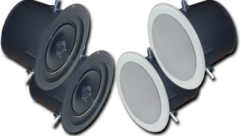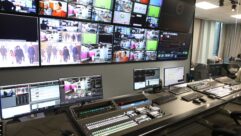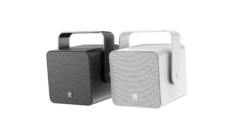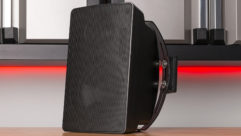SMOOTH AS SILK
May 1, 2001 12:00 PM,
Peter H. Putman, CTS
Of all the tools available for large-screen electronic presentations, mixer/scalers may be the most unique.
CONSIDERING USING BIG ELECTRONIC images in your next production? Perhaps you’ve been put off by the idea of trying to blend signals from such disparate sources as a personal computer, DVD player and hard drive video recorder. Based on outward appearances, these video sources seem to have nothing in common.
The connectors couldn’t be more different. What we think of as a traditional video connector is often a piece of coaxial cable with a small RCA or BNC plug on it. How does that have anything in common with the 15-pin, knuckle-busting HD-style plug on a computer monitor?
Video comes in many flavors. All that’s required to produce an electronic image is some sort of luminance signal (that determines how bright the image is); signals that determine the levels of red, green and blue in the image; and signals that synchronize each frame of the image.
In a broadcast video signal, all of this information travels on one wire. The same thing applies to a consumer video camera or VCR — the luminance, chrominance (color) and sync information is carried on that black cable with the yellow RCA plugs on either end. This is known as a composite video system — the separation of all signals is done in the TV set or monitor.
We can get more sophisticated with video signals. To improve picture quality, the luminance/sync signals (Y) and chrominance (C) can travel on two separate wires. This component signal format is known as S-video, or S-VHS. The three RCA jacks on the rear panel of a DVD player is a component signal format that goes one better than S-video by dividing the chrominance information into two channels (R-Y and B-Y).
So we can deliver video in three different formats: on a single wire, two wires or three wires. Computer video displays aren’t all that different except that they only use component signal formats. Depending on the format, three color channels travel on separate wires, while horizontal and vertical picture sync are carried together (composite sync) or separately (component sync). These formats are known as RGBS and RGBHV, respectively.
MIXING FORMATS, SCALING SIZES
A video mixer/scaler can analyze and convert signals in any of these formats to one standard output format. While the luminance and chrominance information may arrive in different ways, the mixer/scaler translates rapidly between formats and converts everything to one chosen output format. Typically, it will be RGBHV, which is the format used by computer monitors and flat-matrix front projectors.
By converting everything to the same format, a mixer lets us dissolve, cut and wipe between each of these separate video sources as easily as with a conventional broadcast video mixer/switcher. In addition, the mixer converts interlaced scan video sources (composite, S-video, and component video) to progressive scan, matching the progressive-scan format used by computer monitors. But there’s another important step in the process.
Each incoming signal has a specific image resolution, which can be measured as either the total number of electronic scanning lines or the number of horizontal and vertical pixels. Video images have less resolution than images from a graphics workstation computer or even a notebook computer. How then can two images of different sizes and resolutions possibly blend together?
The answer is the video scaler. This is a series of custom-integrated circuits that performs some impressive mathematical calculations on all incoming signals and resizes them to match the output resolution you’ve chosen. If your mixer/scaler is set up to output a RGBHV signal with a specified resolution of 1024×768 pixels (XGA), then all signals connected to the mixer/scaler will be converted to XGA.
This means that lower-resolution video signals may not appear as crisp when enlarged (because the pixels are blown up in size). A better approach is to have the mixer/scaler create additional duplicate pixels from the original material, interpolating what these pixels should look like based on the original signal. That takes a ton of microprocessing power and isn’t easy to pull off.
Higher-resolution signals require a similar juggling act. They will have more pixels than the specified output resolution, so the scaler must throw away, or decimate, data to shrink the image.
To the end-user the process is largely transparent. Setting up a mixer/scaler will require you to specify an output resolution, typically one that matches common computer display resolutions (640×480 VGA, 800×600 SVGA, 1024×768 XGA, 1365×1024 SXGA or 1280×1024 SXGA).
Most mixer/scalers are intelligent enough to detect the incoming signal sources and automatically perform the conversions. You’ll have to connect the cables from your video sources to specific input jacks; then onboard menus will show you the sources you have connected and how you’ve set up the output signal.
WHAT’S IN IT FOR ME?
Why use a mixer/scaler? Because flat-matrix displays all have specific pixel resolutions, their “native” resolutions. For your mixed images to look as sharp and crisp as possible, you’ll want to match that native resolution exactly. The number of times each frame of video is refreshed each second is also important. For flat matrix projectors, you may want to use 60 Hz, 70 Hz, 72 Hz or some other refresh rate. The mixer/scaler lets you do that.
Scalers typically have large, backlit buttons that can contain custom labels for inputs and outputs. There are generally two banks of buttons to allow dissolves, cuts and wipes, plus a joystick or T-bar to execute the effect. Mixer/scalers also have a second output channel for previewing the signal you are going to take, in addition to the main program output channel.
The benefits of mixer/scalers are immediately obvious: Any source of video can be called up on the fly and mixed into a live production. Those sources could include image magnification (IMAG), computer graphics (.jpeg, .tif and PowerPoint images), clips from hard-drive servers or DVD, video rolls from broadcast formats like Betacam SP and DV/DVCAM/DVCPRO, and even video clips from Internet sources.
In short, you are not constrained by the source material. As long as you can interface your source to a mixer/scaler, and the source picture scan rates are supported, you’re in business. These products will work with different aspect ratios, too. Most computer display resolutions work out to a 4×3 or 5×4 aspect ratio. But at least one manufacturer now supports widescreen (16×9) aspect ratios.
WHO MAKES THEM?
Video mixer/scalers are relatively new products, but several manufacturers have jumped on the bandwagon.
Folsom Research of Rancho Cordova, California, was the first manufacturer to successfully market a video mixer/scaler to the rental and staging markets. Its Variable Format Converter (VFC-2200) was able to seamlessly scale and blend a variety of component video signal sources at resolutions up to 1280 by 1024 pixels. A preview output and custom video switcher interface rounded out the package.
Folsom’s ScreenPro takes the concept to a new level, adding support for composite and S-video sources and providing auto-setup of all inputs. A new interface includes a built-in matrix of input and output pushbuttons, as well as pushbuttons for executing cuts, dissolves and wipes. A small LCD display provides all setup and operating information.
The ScreenPro can also key one image on top of another, useful for superimposing text. It features eight separate inputs for component and composite video sources, and a resolution as high as 1600 by 1200 pixels (UXGA). The ScreenPro outputs standard computer display rates and is capable of storing up to 64 pre-programmed transitions in memory.
While Folsom’s VFC-2200 mixer/scaler was the first such product to be widely adopted, Analog Way of Paris, France, has the distinction of rolling out the first fully integrated mixer/scaler with a built-in switcher. The newest version, the Graphic Switcher II, has large, backlit buttons for each input and output, preview and program outputs, and individual pushbuttons for taking each selected effect.
Early models could only support progressive-scan video, requiring an external line doubler. The GSW II supports both interlaced and progressive-scan signals in composite or component form. Depending on configuration, it has eight RGB inputs (including component DTV signals), eight composite video or four S-video inputs. The GSW II will also mix and output signals at HDTV rates.
FSR Inc. of West Paterson, New Jersey, offers the fully integrated, 8-input, dual-output Omni Navigator, which presents the usual video switcher interface for selecting inputs and outputs, plus auto-configuration on any input signal. Three pushbuttons select programmable wipes, cuts or dissolves between sources; and an external video switcher can be interfaced for studio-type operation. Input sources to UXGA are supported, and output signals are fed as standard computer resolutions to SXGA.
Extron Electronics of Anaheim, California, has a full-featured mixer/scaler. Their SGS 408 has eight high-resolution inputs that will take anything from composite video to UXGA workstation images and blend them at standard computer resolutions. Both preview and program outputs are standard. Accessory control panels include a pushbutton panel (RCP 1000) and production switcher (ECP 1000) with T-bar.
RGB Spectrum of Alameda, California, has a simpler configuration in its SynchroMaster 450. It’s not as full-featured as some but allows seamless scaling and blending of four RGB or two RGB and two video signals. The SynchroMaster 450 accepts input signals up to 1280×1024 resolution, and there’s an option to output serial digital video to projectors and monitors so equipped.
ODDS AND ENDS
Each of these products is a fully featured mixer/scaler. This means total control over all signal adjustment parameters (provided you know how to tweak them; otherwise, let the scaler do the calculating). And each product can also be controlled remotely, via an RS-232C interface.
Video effects (cuts, fades and dissolves) can be remotely triggered in conjunction with lighting and stage effects. As the A/V industry adopts IP-type control protocols, you can expect mixer/scalers to adopt IP addressing for placement on custom LANs. Expect direct digital signal connections to follow shortly.
Want to check ’em out? There are several trade shows that show mixer/scalers in operation, including INFOCOMM 2001 in June. (See my INFOCOMM preview in this issue.) Some manufacturers will periodically take their mixer/scalers on the road for demonstrations and training, too. Check with your local staging/rental house or professional A/V dealer to see if such a demo will be in your area.
Peter H. Putman owns PHP Communications, Doylestown, Pennsylvania.










